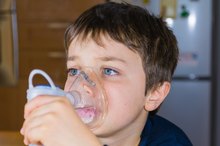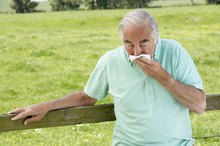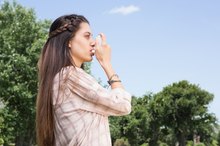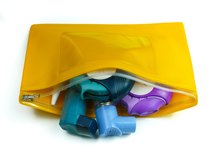What does fact checked mean?
At Healthfully, we strive to deliver objective content that is accurate and up-to-date. Our team periodically reviews articles in order to ensure content quality. The sources cited below consist of evidence from peer-reviewed journals, prominent medical organizations, academic associations, and government data.
- MayoClinic.com: Diseases and Conditions: Asthma: Asthma Inhalers-Which One's Right For You?
- National Center for Biotechnology Information: PubMed:Integrated Breathing and Relaxation Training (the Papworth method) for Adults with Asthma in Primary Care
- National Center for Biotechnology Information: PubMed:Integrated Breathing and Relaxation Training (the Papworth method) for Adults with Asthma in Primary Care
The information contained on this site is for informational purposes only, and should not be used as a substitute for the advice of a professional health care provider. Please check with the appropriate physician regarding health questions and concerns. Although we strive to deliver accurate and up-to-date information, no guarantee to that effect is made.
Nebulizer Alternatives
**A nebulizer is a machine that converts liquid medicine into a mist that can be easily inhaled into the lungs 1.* Nebulizers are used to treat moderate-to-severe cases of chronic airway diseases, including asthma, emphysema and Chronic Obstructive Pulmonary Disease. Occasionally, nebulizers will be used to treat severe symptoms of bronchitis and pneumonia. Nebulizers provide an effective way to administer medicine at home but may prove troublesome to carry around, particularly for those with frequent or unpredictable symptoms. Portable units do exist but if not battery-operated, they must be plugged into an electrical outlet or automobile cigarette lighter to work. *With physician guidance, explore other options, engage in disease management and investigate alternatives to nebulizers.
If you are experiencing serious medical symptoms, seek emergency treatment immediately.
Inhalers
Hand-held, metered-dose inhalers are an alternative to nebulizers. These portable devices deliver a specific dose of aerosolized medicine to the patient’s lungs. In most cases, metered-dose inhalers contain a bronchodilator, a corticosteroid or a combination of both medicines. Not all inhalers use a chemical propellant to push the medication out of the inhaler; dry powder inhalers are released when you take in a deep, fast breath. Treatment and use of an inhaler varies between daily use and emergency relief, depending on the severity of the condition.
- Hand-held, metered-dose inhalers are an alternative to nebulizers.
- Not all inhalers use a chemical propellant to push the medication out of the inhaler; dry powder inhalers are released when you take in a deep, fast breath.
Oral Medications
List of Nebulizer Medications and Ingredients
Learn More
Pharmaceutical options are available to help control asthma and chronic airway disease symptoms. The strongest of these are steroids -- available in pill, tablet or liquid form -- which reduce swelling of the airways and are used as short-term treatment of symptoms. For long-term control, leukotriene modifiers prevent inflammation of the airways and decrease the amount of mucus in the lungs. For patients who suffer from persistent nighttime asthmatic symptoms, theophylline may alleviate symptoms when used in combination with other anti-inflammatory medication. Patients with slight-to-moderate respiratory symptoms may be able to forego nebulizer treatment and benefit from a combined treatment plan which includes inhalers and oral medications 1.
- Pharmaceutical options are available to help control asthma and chronic airway disease symptoms.
- Patients with slight-to-moderate respiratory symptoms may be able to forego nebulizer treatment and benefit from a combined treatment plan which includes inhalers and oral medications 1.
Allergy Treatment and Eliminating Triggers
According to the Asthma and Allergy Foundation of America, “an estimated 20 million Americans suffer from asthma,” 50 percent of these cases being allergic asthma 3. Allergic or extrinsic asthma is characterized by symptoms that are triggered by inhaling allergens such as pet dander, dust mites and mold. An immunotherapy treatment plan may be helpful in controlling and reducing allergy-causing antibodies that trigger allergic asthma and the need for a nebulizer 1. The removal of environmental allergy triggers from your home will decrease the chance of respiratory distress. People suffering from asthma or other chronic airway diseases should take extra care on cold or windy days by covering the nose and mouth with a scarf.
Breathing Techniques
Treatment for Asthmatic Bronchitis
Learn More
Research has shown that two breathing techniques, the Buteyko and Papworth methods, may help reduce asthma symptoms 4. The Buteyko method is based on teaching patients to decrease the depth of their breathing, while the Papworth technique includes a series of breathing and relaxation exercises 4. Yoga may help respiratory symptoms through the integration of breathing techniques or pranayama into yoga stretches and poses.
Exercise
Exercise will not replace nebulizer use, but will improve overall health and may minimize the need for a breathing machine 1. Exercise may sometimes trigger respiratory attacks but adults and children with asthma and other respiratory conditions should strive to remain active.** A healthy lifestyle can improve lung function by strengthening breathing muscles in the chest.
Related Articles
References
- MayoClinic.com: Diseases and Conditions: Asthma: Asthma Inhalers-Which One's Right For You?
- Asthma and Allergy Foundation of America: Asthma Facts and Figures: Prevalence
- Buteyko Breathing: Home Page
- National Center for Biotechnology Information: PubMed:Integrated Breathing and Relaxation Training (the Papworth method) for Adults with Asthma in Primary Care
- KidsHealth: Parents: Medical Problems: Exercise-Induced Asthma
- NHLBI Guidelines for the Diagnosis and Treatment of Asthma. Expert panel report 3: guidelines for the diagnosis and management of asthma.
- Biddiscombe, Martyn. (2017). Inhaler characteristics in asthma. European Respiratory & Pulmonary Diseases. 03. 32. doi:10.17925/ERPD.2017.03.01.32.
- The Cleveland Clinic. Home nebulizer instructions.
- American Academy of Allergy Asthma & Immunology. Tips to remember: inhaled asthma medications.
Writer Bio
A resident of Toronto, Joy Kimber has been writing online since 2009. She provides travel-related content for LIVESTRONG Lifestyle and enjoys writing articles that focus on business, career, and psychology for eHow. She holds a Bachelor of Commerce and Administration from Bishop's University.








